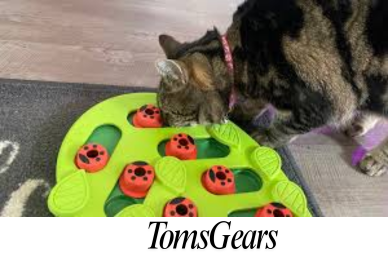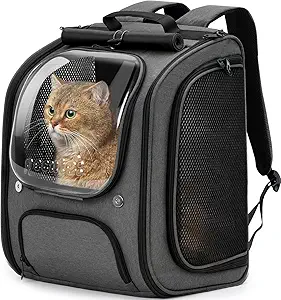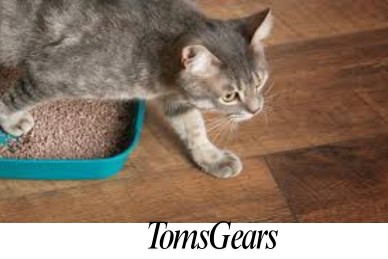How to Help a Blind Cat Find the Litter Box?
As a pet owner with a blind cat, finding the right way to help them use the litter box can be really tough. I totally get how it’s a big adjustment for both of us when they lose their sight. But don’t worry, with some simple tricks and a little patience, we can make sure our furry friend stays comfortable and stress-free during their litter routine. The main thing is understanding that blind cats rely a lot on their other senses like smell, touch, and sound to get around. By tapping into those senses and making a few easy changes, we can create a litter box setup that’s easy for them to find and use.
Step #1: Choose the Right Litter Box Location
Imagine trying to find the bathroom blindfolded in your own home. It’s not the most pleasant experience, right? The same goes for your furry friend. Selecting an appropriate location for the litter box is crucial for your blind cat’s success. Place the litter box in a quiet, low-traffic area of your home to avoid noisy or high-traffic zones that may startle or confuse your cat. Ensure the litter box is easily accessible and not obstructed by furniture or other obstacles. Consider placing the litter box in a corner or against a wall to provide a sense of security and help your cat navigate more easily. Opt for a permanent location and avoid moving the litter box frequently, as consistency is key for your blind cat’s routine.
Step #2: Create a Tactile Path to the Litter Box
Since your blind cat relies heavily on their sense of touch, creating a tactile path can help guide them to the litter box. Use textured surfaces or mats with distinct textures and place them leading from your cat’s favorite resting spots to the litter box. Experiment with different textures, such as rubber-backed bath mats, textured carpet runners, or even pieces of sandpaper. Make sure the tactile path is consistent and doesn’t have any obstructions or gaps that could confuse your cat. Consider using catnip or treats along the path to encourage your cat to follow the scent and associate it with the litter box.
Step #3: Use Scent Trails to Guide Your Blind Cat
Cats have an incredible sense of smell, and you can use this to your advantage when helping your blind cat find the litter box. Place a few drops of a strong-smelling, non-toxic essential oil (like lavender or eucalyptus) near the litter box to create a distinct scent trail. Use treats or catnip to create a scent path leading to the litter box. Refresh the scent trail regularly to ensure it remains strong and effective. Be consistent with the scent you choose to avoid confusing your cat.
Step #4: Utilize Auditory Cues for Litter Box Identification
Since your blind cat cannot rely on visual cues, incorporating auditory cues can help them identify the litter box location. Place a ticking clock or a battery-operated sound source near the litter box to create an audible marker. Use a recorded sound, like a bell or a specific tune, that your cat can associate with the litter box. Ensure the auditory cue is distinct and not overpowering or frightening for your cat. Gradually introduce the auditory cue and pair it with positive reinforcement to help your cat make the connection.
Step #5: Select the Appropriate Litter Type and Box Style
Not all litter boxes and litter types are created equal, especially when it comes to catering to the needs of a blind cat. Here’s what to keep in mind:
- Low and uncovered is the way to go: Opt for a low-sided and uncovered litter box. This makes it easier for your cat to enter and exit the box, especially if they have any mobility limitations.
- Clumping litter for the win: Clumping litter can be a lifesaver, as it allows for easier scooping and reduces the risk of accidents due to an unclean box.
- Consider the litter depth: Some blind cats may prefer a shallower layer of litter, as it can feel less overwhelming under their paws. Experiment with different depths to see what your cat finds most comfortable.
Step #6: Positive Reinforcement and Consistency
Patience and positive reinforcement are key when helping your blind cat learn to use the litter box. Reward your cat with treats, praise, or affection when they successfully use the litter box. Be consistent with your litter box setup, training techniques, and routine. Avoid scolding or punishing your cat if they have accidents, as this can create stress and confusion. Regularly clean the litter box to maintain a pleasant scent and environment. Gradually introduce changes to the litter box setup to avoid overwhelming your cat.
The Importance of Litter Box Accessibility for Blind Cats
Ensuring litter box accessibility for blind cats is of paramount importance for their well-being and quality of life. When blind felines struggle to locate or access the litter box, it can lead to accidents, unsanitary living conditions, and potential health risks such as urinary tract infections or skin irritations. Moreover, the stress and frustration associated with an inaccessible litter box can manifest in undesirable behaviors like excessive meowing, scratching, or even aggression.
By investing time and effort into creating a litter box setup tailored to their unique needs, you not only promote their independence and confidence but also foster a stronger bond between you and your feline companion. A well-designed, accessible litter box environment can significantly reduce anxiety and distress for your blind cat, positively impacting their overall emotional well-being. This simple act of care and understanding demonstrates your commitment to their comfort and safety, strengthening the trust and affection in your relationship. Ensuring litter box accessibility is a vital aspect of responsible pet ownership for blind cats.
Conclusion
At the end of the day, helping a blind cat find the litter box is all about understanding their unique needs and being creative with solutions. It might take some trial and error to figure out what works best for your furry pal, but stick with it. Celebrate the little wins and don’t get discouraged. If you ever feel stuck or have more questions, reach out to your vet or cat behavior experts for extra guidance. Just know that with a little effort and lots of love, you can totally make this work. Your blind cat is counting on you for a safe, stress-free litter routine. You’ve got this!






